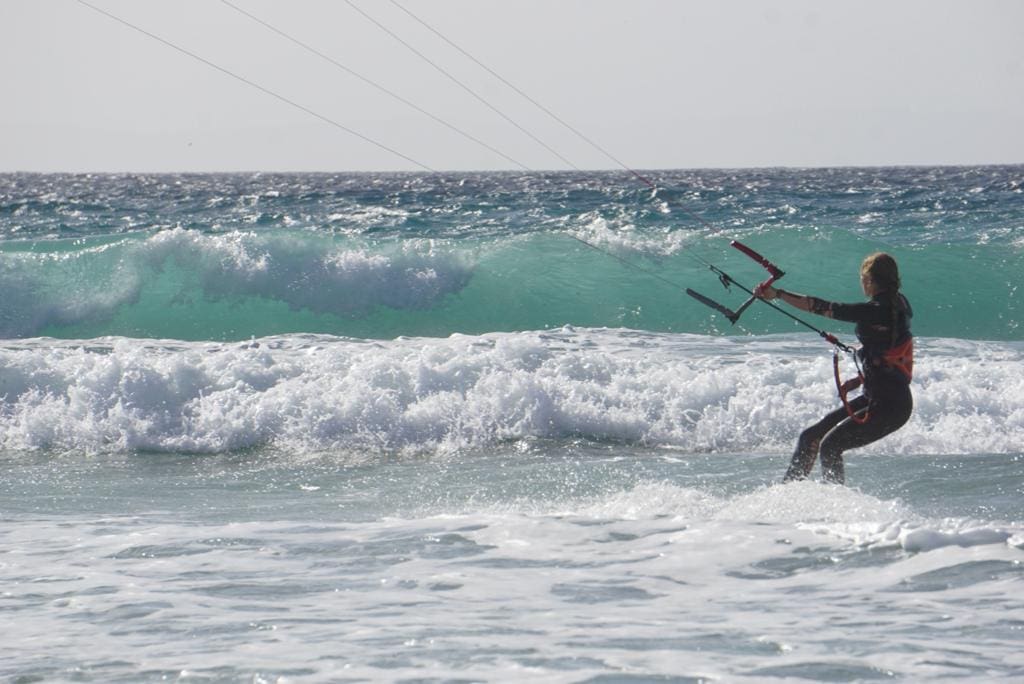We will offer you in this article some basic tips to do the waterstart in kitesurfing.
The way to get out of the water kiting with the board requires having learned the basic steps with the kite on the beach before:
- Control of the kite on the ground
- Control of bodydrag
We recommend practicing this maneuver in a professional kitesurf center or with someone experienced by our side, at least on the first occasions. Once you have known the basic principles to practice on your own.
First of all, before entering the water we must prepare the board for our feet. With the kite parked and taking the time necessary for this essential task.
We prepare the footstraps for our feet. If the grips for the feet are too narrow, we will have one more obstacle when it comes to putting on the board. The mission of the foot grips is so that the board does not come off.
That the foot enters easily in your first waterstarts is key so that we put the board comfortably.
STEPS TO FOLLOW
- To begin we will enter a few meters into the water. We walked towards the shore, right hand on the board and left hand on the kite as we learned the first day on land.
- Already located, with enough depth in the water, in case we make a mistake that the water covers us enough and we have enough distance from the ground. Also with enough distance from the shore so as not to hit anyone. We will keep our kite in the neutral zone of the window, 12 o’clock or zenith.
- Once in the water we will place our kitesurf board on our feet sitting in the water in such a way that we will control the kite with one hand centered on the bar and we will hold the board with the other. The life jacket will give us that extra buoyancy to keep us on the water correctly.
- To do the waterstart in kitesurf correctly, it is very important to keep our back to the wind at all times so as not to lose the true position of the wind window, if we become unbalanced we will help ourselves with the legs exerting flexion and extension to return to the starting position.
- Before starting the water start maneuver, we will flex our legs in order to have the board close to our body. We will try that table and body form a block. Although we will not shrink the legs too much, since if we are too compact when standing up, it will be more difficult when extending the legs.
- In the first attempts at waterstart in kitesurfing, we will move the kite, for example, from 11 o’clock in the wind window (we always start from the zenith) to 3 o’clock, in case we start the maneuver with the right leg in front. The fact of starting the maneuver with the kite slightly at 11 o’clock will offer us greater power, it will not be necessary in case of having a considerable wind intensity.
- As soon as the path of the kite transmits us enough power to get out of the water, we will extend our front leg and semi-flex the back.
- We will keep our board in the direction of the wind at all times in our first attempts at waterstart, or also known for heading long. As we gain confidence we will hammer the edge progressively to adopt a course from length to cross and across to upwind.
We will always remember to raise the kite again at 1 – 2 hours in case of starting with the right leg and we will repeat the movement as many times as necessary if we consider that the traction of the kite is insufficient, until our speed is the same. suitable for gliding on water.
Once we have the appropriate speed, we leave the kite at 45º and concentrate on the position of the body. To enjoy!!
We advise you to keep the tip of the board out of the water at all times during the maneuver and to move the kite more abruptly or more slowly depending on the intensity of the wind.
More info: Juan I. Fernández
☎️ +34 615683051
https://www.tarifakitepassion.com info@tarifakitepassion.com



